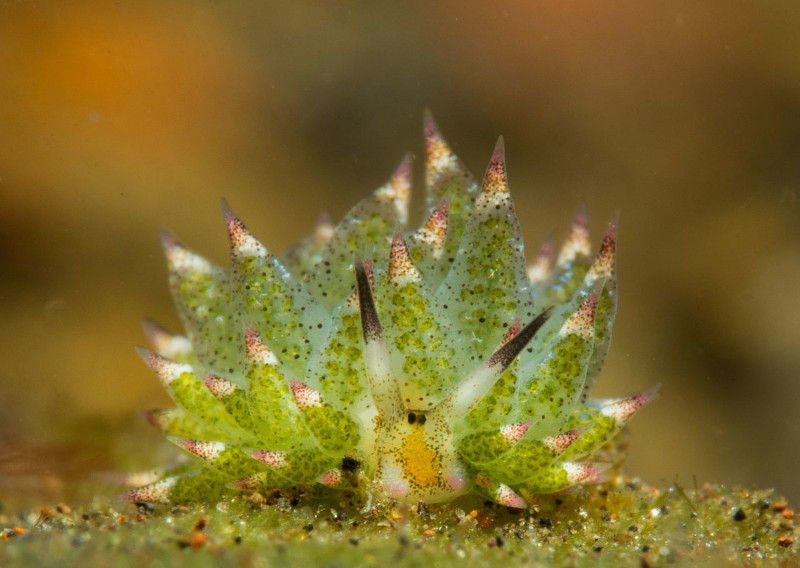Leaf Slug Facts
- This pleasant-looking denizen of the oceans of the world bears, among others, the common name of the Leaf Slug. It’s also known to many by several other alternate names. These include such similar terms as leaf sheep and salty ocean caterpillar.
- Professionals, such as researchers, meanwhile, typically refer to the creature by its formal scientific name. That’s the truly tongue-twisting term of Costasiella kuroshimae, however. It further represents a member of a highly unique form of sea slug.
- It’s also a species only recently identified. That’s because it remained unidentified to science until 1993. The credit for the first recognition of the creature as a separate and distinct species further goes to a respected Japanese researcher from the region.
- For the moment, the IUCN has no listing for this species. Any such listing of its status would be reflected on the organization’s Red List of Threatened Species. That lack of status of any kind simply reflects the fact that, for now, science knows little about it.
- It’s likely, however, that the fascinating Leaf Slug faces several threats to its continued existence as a species, like many now do. Given its habitat, the dangers of habitat loss likely pose a danger to it. Its greatest threat, however, likely comes from climate change.
Related Articles
Leaf Slug Physical Description
The fabulous Leaf Slug, with its eye-catching appearance, fully merits appreciation as a work of Nature. It accomplishes this, however, wholly regardless of physical size. That holds true because it’s actually a tiny species, especially in comparison with some of its relatives.
Individuals also vary significantly in terms of size, as well. This further occurs entirely without regard to gender, as far as limited research indicates. Unlike many of its relatives, therefore, this particular gastropod displays no noticeable degree of sexual dimorphism.
The majority of observed specimens attain an overall length measuring roughly 0.2 in (5 mm). Exceptional measured specimens, though, sometimes reach lengths of as much as 0.39 in (1 cm). Research remains limited, though for now these statistic seem to hold up.
Some of the alternate names for the Leaf Slug understandably derive from its physical appearance. A pair of long, slender, dark colored rhinophores protrude from the top of its head, resembling horns, or insect antennae. The head also possesses two dark eyes.
Precise color patterns vary, yet some shades predominate. Most individuals mainly display a bright green shade across their bodies and spiny protuberances. Some specimens, however, also display small patches of various other colors on the tips of the structures.
- Kingdom: Animalia
- Phylum: Mollusca
- Class: Gastropoda
- Order: Sacoglassa
- Family: Costasiellidae
- Genus: Cosatasiella
- Species: C. kuroshimae
Leaf Slug Distribution, Habitat, and Ecology
Due to the fact that science only recently discovered the fabulous Leaf Slug, the full extent of its range cannot be stated with complete certainty. For the moment, however, the known range of the magnificent sea creature sadly remains moderately restricted.
The limited portion of the globe in which it’s known to appear covers a portion of the waters of southeast Asia. The original discovery of the tiny gastropod occurred off the coast of the island of Kuroshima, in Japan. Since then, though, it’s been seen in a few other places.
The other locations in which it’s been sighted consist of the waters around the Philippines and Indonesia. In all regions in which it’s been sighted to date, though, the habitat choice remains the same. It appears to live solely in the shallow waters along the coastline.
Beyond these facts, however, researchers presently know very little about its lifecycle. Among the relative dearth of information, though, one startling fact does stand out. That’s because these tiny marvels actually use the process of photosynthesis, like plants!
The diet of the remarkable Sea Slug seems to consist almost entirely of sea algae. When the animal consumes this, it actually draws the chloroplasts from the algae. That enables them to photosynthesize, which actually makes individuals glow with bioluminescence.
Species Sharing Its Range
Check out our other articles on 4 Magnficent Alaskan Mammals, Crowned Eagle, Padirac Cave, Alaskan Timber Wolf, Black Witches’ Butter, Knysna Seahorse, Giant Forest Ant, Saltwater Crocodile

